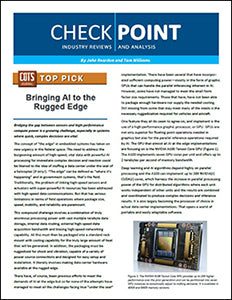
Bridging the gap between sensors and high-performance compute power is a growing challenge, especially in systems where quick, complex decisions are vital.
The concept of “the edge” in embedded systems has taken on new urgency in the federal space. The need to address the burgeoning amount of high-speed, vital data with powerful AI processing for immediate complex decision and reaction could be likened to the idea of stuffing a data center under the seat of a helicopter (if only!). “The edge” can be defined as “where it’s happening” and in government systems, that’s the field. Traditionally, the problem of linking high-speed sensors and actuators with super-powerful AI resources has been addressed with high-speed data communications. But that has serious limitations in terms of field operations where package size, speed, mobility, and reliability are paramount.
{formbuilder:67393}

Today’s AI computer architectures - relying on switched fabrics - need new packaging approaches that can handle the demanding requirements of military applications in the field. But program leaders face the dilemma of meeting these requirements using open standards that were never initially designed for them.

